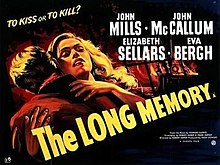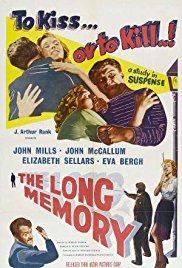The Long Memory *** (1953, John Mills, John McCallum, Elizabeth Sellars, Eva Bergh) – Classic Movie Review 7751
Director Robert Hamer’s 1953 British black-and-white film noir thriller The Long Memory is a rather tame and routine crime drama that, as a story, is not always too convincing and probably will not live too long in the memory. But John Mills’s engrossing star performance keeps it going and so does Hamer’s atmospheric film-making.
It is this location film-making at London’s Waterloo railway station, Shad Thames in south London, the North Kent Marshes on the Thames Estuary, and the dingy backstreets of Gravesend, northwest Kent, mainly in Queen Street, that is its claim to attention and acclaim. These dark and bleak settings and the film’s grim and gloomy atmosphere of backstreets, mud and desolation make The Long Memory a fascinating example of British film noir.
Mills plays Phillip Davidson, a freed convict who was framed for killing and now he is out after a long jail term of 12 years in prison for revenge on his duplicitous old girlfriend Fay (Elizabeth Sellars). But his anger is tempered by refugee Ilse (Eva Bergh) and the discovery of some new evidence. So can he drop the self-destructive revenge and make a new life for himself? John McCallum co-stars as the policeman, Superintendent Bob Lowther, who keeps the hero under surveillance.
The film’s problem is that the plot is not really compelling enough and that it is hard to get worked up to care much about the outcome of the story, based on the 1951 novel by Howard Clewes. However, surprisingly mild and even clunky though the film may be for a picture directed by Hamer and starring Mills, The Long Memory remains interesting and unusually atmospheric throughout.
Also in the cast are Geoffrey Keen, John Chandos, Vida Hope, John Slater, Thora Hird, Harold Lang, John Horsley, Laurence Naismith, Peter Jones, Christopher Beeny, Michael Martin Harvey, Mary Mackenzie, John Glyn-Jones, Fred Johnson, Ernest Clark, Arthur Mullard, Denis Shaw, Julian Somers and Russell Waters. It is the last film of Thirties British star Henry Edwards, who has a small role as a judge.
Mills recalled it as ‘an extremely good thriller’ though he says that Hamer had a drink problem and that he fell into the Thames twice while filming night shots, walking backwards looking through his viewfinder.
Studio work on the film took place at Pinewood Studios. Many of the houses in the film’s locations were demolished soon after. It had a royal gala premiere at the now demolished Leicester Square Theatre (Odeon West End) on 22 January 1953 and was released next day.
Howard Clewes (27 October 1912 – 29 January 1988) wrote eight film scripts between 1951 and 1974 and 20 action novels between 1938 and 1979. He was nominated for a BAFTA for Best Screenplay in 1960 for The Day They Robbed the Bank of England.
The films of Robert Hamer are: Dead of Night (1945) [the ‘haunted mirror’ sequence], Pink String and Sealing Wax (1945), It Always Rains on Sunday (1947), Kind Hearts and Coronets (1949), The Spider and the Fly (1949), His Excellency (1952), The Long Memory (1953), Father Brown (1954), To Paris with Love (1955), The Scapegoat (1959) and School for Scoundrels (1960).
Hamer was a recovering alcoholic who fell off the wagon while making School for Scoundrels, was sacked on the spot and never worked in films again. He was gay in an era when it was illegal in the UK. He died of pneumonia at St Thomas’s Hospital in London, aged 52.
© Derek Winnert 2018 Classic Movie Review 7751
Check out more reviews on http://derekwinnert.com



